 | | | Switch to: Europe, USA, New Zealand, Antarctica Credit: NOAA/Ovation  Planetary K-index Planetary K-index
Now: Kp= 2 quiet
24-hr max: Kp= 4 unsettled
explanation | more data
Interplanetary Mag. Field
Btotal: 4.4 nT
Bz: 1.9 nT north
more data: ACE, DSCOVR
Updated: Today at 2352 UT  Coronal Holes: 05 Sep 17 Coronal Holes: 05 Sep 17 
There are no large coronal holes on the Earthside of the sun. Credit: NASA/SDO.  Noctilucent Clouds Latest images from NASA's AIM spacecraft show that the 2017 northern summer season for noctilucent clouds has finished. Switch view: Europe, USA, Asia, Polar Updated at: 09-03-2017 01:55:03 Noctilucent Clouds Latest images from NASA's AIM spacecraft show that the 2017 northern summer season for noctilucent clouds has finished. Switch view: Europe, USA, Asia, Polar Updated at: 09-03-2017 01:55:03  SPACE WEATHER
NOAA Forecasts | | Updated at: 2017 Sep 05 2200 UTC FLARE | 0-24 hr | 24-48 hr | CLASS M | 75 % | 75 % | CLASS X | 25 % | 25 % |  Geomagnetic Storms: Geomagnetic Storms:
Probabilities for significant disturbances in Earth's magnetic field are given for three activity levels: active, minor storm, severe storm Updated at: 2017 Sep 05 2200 UTC Mid-latitudes | 0-24 hr | 24-48 hr | ACTIVE | 15 % | 15 % | MINOR | 40 % | 35 % | SEVERE | 45 % | 50 % | High latitudes | 0-24 hr | 24-48 hr | ACTIVE | 01 % | 15 % | MINOR | 10 % | 35 % | SEVERE | 90 % | 45 % | | | |  | | | | | | | | | | | Lights Over Lapland is excited to announce that our Customisable Aurora Adventures are available for immediate booking! Reserve your adventure of a lifetime in Abisko National Park, Sweden today! | | | DOES STORMY SPACE WEATHER CONFUSE WHALES? Mass strandings of whales have often been documented, but their causes remain unclear. Researchers from Europe have just published a study in the International Journal of Astrobiology suggesting that some strandings are triggered by strong geomagnetic storms. Whales' magnetic sense can play an important role in orientation and migration, and this sense may become confused by geomagnetic disturbances at high latitudes. Read the original research (open access) from Cambridge University Press. A SOLAR STORM IS COMING: Yesterday during a flurry of M-class eruptions, sunspot AR2673 hurled a CME toward Earth. NOAA forecasters say the cloud is likely to arrive late on Sept. 6th, causing moderately-strong G2-class geomagnetic storms with isolated periods of strong G3-class storming on Sept. 6th and 7th. Click to play a movie of the incoming storm cloud recorded by the Solar and Heliospheric Observatory: 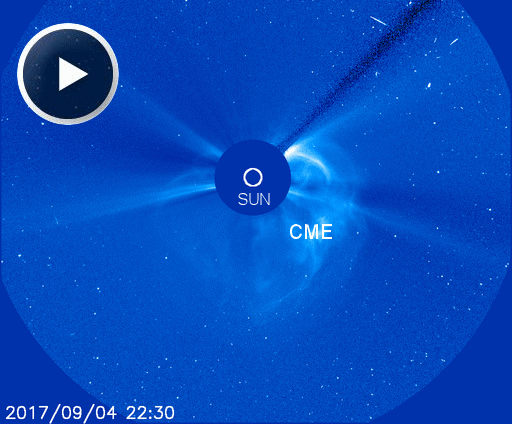
After the CME arrives, auroras will likely appear over places such as Alaska, Scandinavia, Iceland, and Greenland, and perhaps even northern-tier US states from Maine to Washington. Glare from the full Moon will mitigate visibility to some degree. If the storms are strong enough, however, auroras could pierce the moonlight. Monitor the realtime aurora gallery for sightings and stay tuned for updates. Free: Aurora Alerts Realtime Space Weather Photo Gallery
ROSE QUARTZ CRYSTAL ECLIPSE PENDANTS: On Aug. 21st during the Great American Solar Eclipse, the students of Earth to Sky Calculus launched 11 space weather balloons from the path of totality. They aimed to photograph the Moon's shadow from the stratosphere--and they succeeded. As a fundraiser, some of the balloons carried jewelry. Here is a rose quartz crystal pendant entering the Moon's shadow more than 90,000 feet above the Malheur National Forest in eastern Oregon: 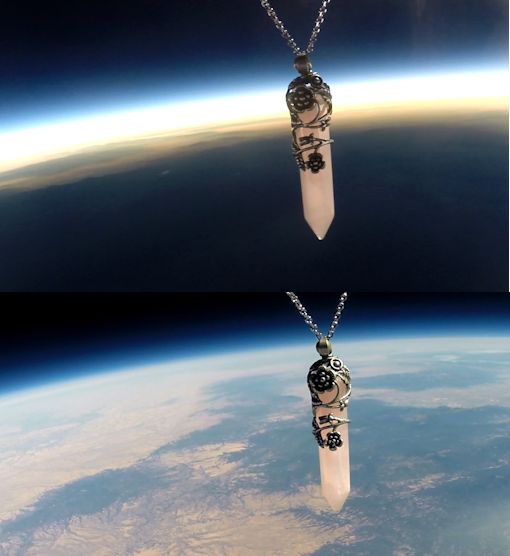
During the 2.5 hour flight, the pendants were wrapped in the Moon's shadow for more than two minutes, experiencing a spooky darkness colder than -50 C. You can have one for $149.95. Each crystal pendant comes with a unique gift card showing the jewelry passing through the Moon's shadow and floating at the top of Earth's atmosphere. The interior of the card tells the story of the flight and confirms that this gift has been to the edge of space and back again. Far Out Gifts: Earth to Sky Store
All proceeds support hands-on STEM education SURPRISE GEOMAGNETIC STORM: With the Moon glaring brightly and an incoming CME still two days away from Earth, last night's aurora forecast was not promising. In Tromsø, Norway, the forecast was wrong. Photographer Bernt Olsen looked up on the evening of Sept.4th and saw a fountain of green and purple lights directly overhead: 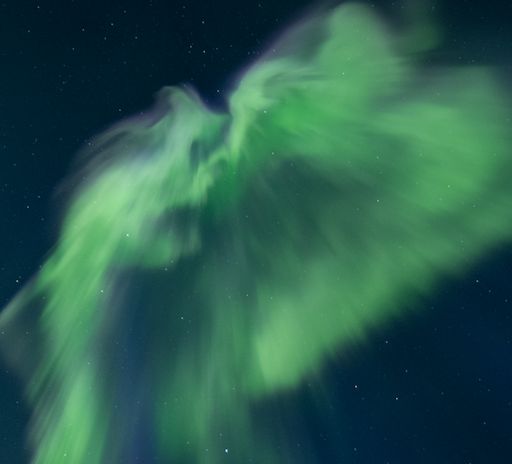
"I witnessed three 'coronas' like this one in just 10 minutes," says Olsen. "It was a good display."
What happened? Just before the luminous outburst, magnetic fields in the solar wind tipped south, opening a crack in Earth's magnetosphere. Solar wind poured to fuel a G1-class geomagnetic storm--a pleasant surprise, indeed. This display could herald an even bigger one later this week when the CME arrives. Free: Aurora Alerts Realtime Aurora Photo Gallery
Solar Eclipse Photo Gallery
Every night, a network of NASA all-sky cameras scans the skies above the United States for meteoritic fireballs. Automated software maintained by NASA's Meteoroid Environment Office calculates their orbits, velocity, penetration depth in Earth's atmosphere and many other characteristics. Daily results are presented here on Spaceweather.com. On Sep. 5, 2017, the network reported 40 fireballs.
(40 sporadics)  In this diagram of the inner solar system, all of the fireball orbits intersect at a single point--Earth. The orbits are color-coded by velocity, from slow (red) to fast (blue). [Larger image] [movies] Potentially Hazardous Asteroids ( PHAs) are space rocks larger than approximately 100m that can come closer to Earth than 0.05 AU. None of the known PHAs is on a collision course with our planet, although astronomers are finding new ones all the time. On September 5, 2017 there were 1803 potentially hazardous asteroids.  | Recent & Upcoming Earth-asteroid encounters: | Asteroid | Date(UT) | Miss Distance | Velocity (km/s) | Diameter (m) | | 2017 QQ1 | 2017-Aug-31 | 4.8 LD | 10.2 | 39 | | 3122 | 2017-Sep-01 | 18.5 LD | 13.5 | 5376 | | 2017 QT17 | 2017-Sep-01 | 17.3 LD | 10 | 55 | | 2017 QG18 | 2017-Sep-01 | 4.4 LD | 6.6 | 13 | | 2017 QV32 | 2017-Sep-02 | 12 LD | 11 | 21 | | 2017 QR32 | 2017-Sep-02 | 2.8 LD | 18 | 17 | | 2017 QB35 | 2017-Sep-03 | 0.9 LD | 4.1 | 5 | | 2017 RB | 2017-Sep-06 | 3.8 LD | 5.2 | 9 | | 2017 OP68 | 2017-Sep-10 | 20 LD | 11.7 | 287 | | 2017 QK18 | 2017-Sep-11 | 14.8 LD | 7.8 | 45 | | 2014 RC | 2017-Sep-11 | 15.1 LD | 8.9 | 16 | | 2017 PR25 | 2017-Sep-23 | 17.9 LD | 13.5 | 241 | | 1989 VB | 2017-Sep-29 | 7.9 LD | 6.3 | 408 | | 2012 TC4 | 2017-Oct-12 | 0.1 LD | 7.6 | 16 | | 2005 TE49 | 2017-Oct-13 | 8.5 LD | 11.2 | 16 | | 2013 UM9 | 2017-Oct-15 | 17 LD | 7.8 | 39 | | 2006 TU7 | 2017-Oct-18 | 18.7 LD | 13.3 | 148 | | 171576 | 2017-Oct-22 | 5.8 LD | 21.2 | 677 | | 2003 UV11 | 2017-Oct-31 | 15 LD | 24.5 | 447 | Notes: LD means "Lunar Distance." 1 LD = 384,401 km, the distance between Earth and the Moon. 1 LD also equals 0.00256 AU. MAG is the visual magnitude of the asteroid on the date of closest approach. | | Cosmic Rays in the Atmosphere |
Readers, thank you for your patience while we continue to develop this new section of Spaceweather.com. We've been working to streamline our data reduction, allowing us to post results from balloon flights much more rapidly, and we have developed a new data product, shown here: 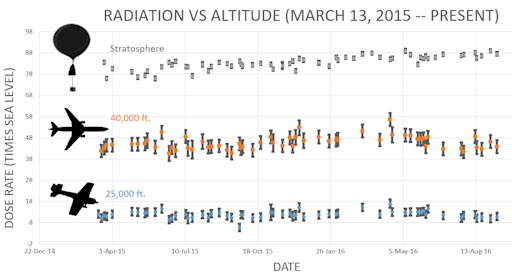
This plot displays radiation measurements not only in the stratosphere, but also at aviation altitudes. Dose rates are expessed as multiples of sea level. For instance, we see that boarding a plane that flies at 25,000 feet exposes passengers to dose rates ~10x higher than sea level. At 40,000 feet, the multiplier is closer to 50x. These measurements are made by our usual cosmic ray payload as it passes through aviation altitudes en route to the stratosphere over California. What is this all about? Approximately once a week, Spaceweather.com and the students of Earth to Sky Calculus fly space weather balloons to the stratosphere over California. These balloons are equipped with radiation sensors that detect cosmic rays, a surprisingly "down to Earth" form of space weather. Cosmic rays can seed clouds, trigger lightning, and penetrate commercial airplanes. Furthermore, there are studies ( #1, #2, #3, #4) linking cosmic rays with cardiac arrhythmias and sudden cardiac death in the general population. Our latest measurements show that cosmic rays are intensifying, with an increase of more than 13% since 2015: 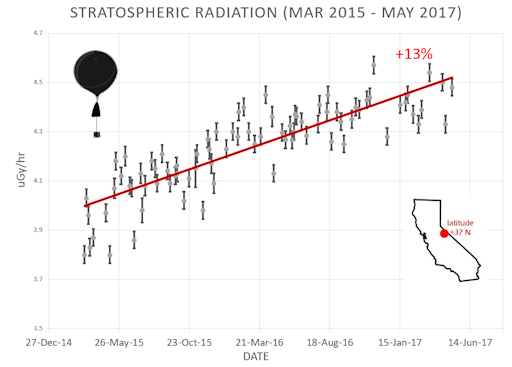
Why are cosmic rays intensifying? The main reason is the sun. Solar storm clouds such as coronal mass ejections (CMEs) sweep aside cosmic rays when they pass by Earth. During Solar Maximum, CMEs are abundant and cosmic rays are held at bay. Now, however, the solar cycle is swinging toward Solar Minimum, allowing cosmic rays to return. Another reason could be the weakening of Earth's magnetic field, which helps protect us from deep-space radiation. The radiation sensors onboard our helium balloons detect X-rays and gamma-rays in the energy range 10 keV to 20 MeV. These energies span the range of medical X-ray machines and airport security scanners. The data points in the graph above correspond to the peak of the Reneger-Pfotzer maximum, which lies about 67,000 feet above central California. When cosmic rays crash into Earth's atmosphere, they produce a spray of secondary particles that is most intense at the entrance to the stratosphere. Physicists Eric Reneger and Georg Pfotzer discovered the maximum using balloons in the 1930s and it is what we are measuring today. | | The official U.S. government space weather bureau | | | The first place to look for information about sundogs, pillars, rainbows and related phenomena. | | | Researchers call it a "Hubble for the sun." SDO is the most advanced solar observatory ever. | | | 3D views of the sun from NASA's Solar and Terrestrial Relations Observatory | | | Realtime and archival images of the Sun from SOHO. | | | from the NOAA Space Environment Center | | | a proud supporter of science education and Spaceweather.com | | | fun to read, but should be taken with a grain of salt! Forecasts looking ahead more than a few days are often wrong. | | | from the NOAA Space Environment Center | | | the underlying science of space weather |  | Reviews here can help you to pick up best memory foam mattresses. | | | These links help Spaceweather.com stay online. Thank you to our supporters! | | | | | | | | |  | |  |   | ©2017 Spaceweather.com. All rights reserved. This site is penned daily by Dr. Tony Phillips. | |

